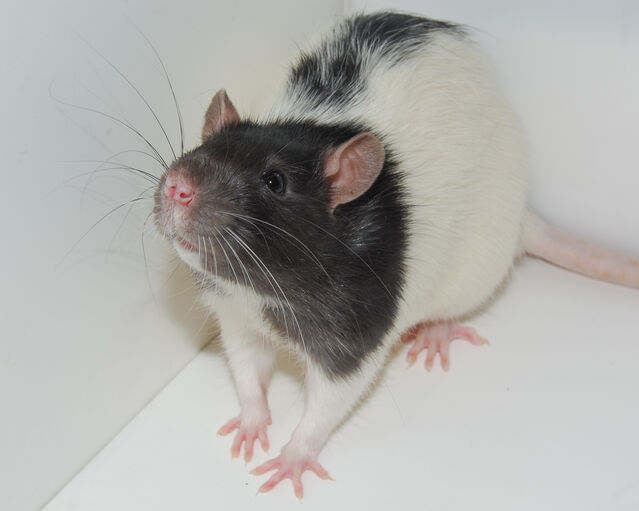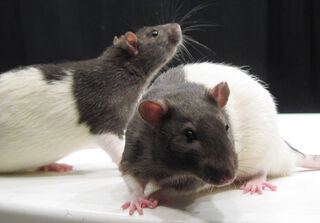Teamwork
How Does a Rat Ask for Help?
Ultrasonic begging calls and odor cues elicit helping behavior from fellow rats.
Posted October 13, 2022 Reviewed by Lybi Ma
Key points
- Rats regularly engage in reciprocal cooperation, where individuals help those who have helped them in the past.
- To ask for help, rats produce ultrasonic begging signals. Increasing the rate of these calls increases helping behavior.
- Olfactory cues are also important. Rats are more likely to help a fellow rat obtain food when it smells hungry or helpful.

Michael Taborsky, a behavioral ecologist at the University of Bern in Switzerland, has spent decades investigating cooperation and helpfulness in different animal species, including common brown rats. His studies, which take advantage of the natural sociality of rats, are revealing the communication mechanisms underlying reciprocal cooperation.
Ultrasonic Begging
In a study published a few years back, Taborsky and colleagues found that hungry adult rats appear to ask other unrelated adults for help in getting food. They tested pairs of rats in a food-provisioning task where the animals take turns in providing food to one another with the help of a moveable tray. The researchers noted that when a rat was hungry, it showed three behaviors that appear to serve a begging function. The rat would first reach out for the food, then start producing 50-kHz calls directed toward its partner, and finally try to grab its partner physically or otherwise get its attention. In this study, the first two behaviors (reaching toward the food and producing calls) increased the propensity of the partner rat to provide food to the hungry rat.
“We were left with the impression that this is a clear indication of begging and a corresponding helping response — a communicative process between the two partners that looked a lot like the begging signal in baby birds asking for food from the parents,” says Taborsky.
To test if these ultrasonic calls really are a begging signal that elicits helping behavior in rats, Taborsky and colleagues conducted a study where they doubled the rate of the calls using playbacks. They found that rats exposed to a higher rate of ultrasonic calls increased their food provisioning to their partner. Begging works, the squeaky rat gets the food.
Helping Themselves
Why would a rat act in a seemingly altruistic way? According to Taborsky, it’s because they themselves will benefit, too.

In another study, Taborsky and colleagues found that for cooperation among social partners, reciprocity is more important than relatedness. Rats prefer to provide food to helpful fellow rats and are even more willing to help non-related animals that have helped them in the past.
This might seem counter-intuitive at first; many hypotheses posit the importance of relatedness in explaining why one animal would help another. But Taborsky says that in rat social groups, which can include up to 200 individuals, there are a lot of interactions between unrelated rats. Being helpful to an unrelated individual could increase your chances of getting something back in the future.
Other recent experiments by Taborsky’s group have shown the importance of olfactory cues to rats in these situations. In one study, the researchers eliminated all other cues and provided rats with odor cues from either hungry or well-fed rats located in different rooms.
“We found that rats are much more likely to help a social partner to obtain food when this partner is hungry,” says Taborsky. “The information they use to decide whether this partner is really in need is olfactory, so they can smell if a partner is in a bad nutritional state.”
In another study, the researchers showed that just the odor of a rat engaged in helpful behavior was enough to elicit cooperation in their partner. Apparently, rats can smell whether or not their partner is cooperative or stingy, even when they do not experience the behavior themselves.
Cooperative Creatures
Taborsky says that since rats are social, trainable, and easy to work with, they make an ideal organism in which to study reciprocal cooperation — though this behavior is by no means unique to rats.

“In a recent review, we listed more than 100 species that show strong evidence for reciprocal cooperation, spanning from nematode worms to humans,” he says.
Although relatedness is often used to explain cooperative behavior (that is, if you’re related to an individual, you’re more likely to help them because you share common genes), Taborsky says there is more to the story.
“We think that reciprocal cooperation and the possibility of increasing the helpfulness of social partners by being generous yourself is much more important in nature than is currently understood,” he says. “Humans are reciprocators in all different sorts of situations. But also in animals, we see the evolutionary roots of this reciprocal cooperativeness.”
References
Gerber N, Schweinfurth MK, and Taborsky M. 2020. The smell of cooperation: Rats increase helpful behavior when receiving odour cues of a conspecific performing a cooperative task. Proceedings of the Royal Society B 287: 20202327. Doi: 10.1098/rspb.2020.2327.
Paulsson NI and Taborsky M. 2022. Norway rats help social partners in need in response to ultrasonic begging signals. Ethology. Doi: 10.1111.eth.13333.
Schneeberger K, Röder G, Taborsky M (2020) The smell of hunger: Norway rats provision social partners based on odour cues of need. PLoS Biol 18(3): e3000628. Doi: 10.1371/journal.pbio.3000628.
Schweinfurth MK, Taborsky M. 2018. Norway rats (Rattus norvegicus) communicate need, which elicits donation of food. J Comp Psychol. 2018 May;132(2):119-129. doi: 10.1037/com0000102.
Schweinfurth MK, Taborsky M. 2018. Relatedness decreases and reciprocity increases cooperation in Norway rats. Proceedings of the Royal Society B 285: 20180035. Doi: 10.1098/rspb.2018.0035.


